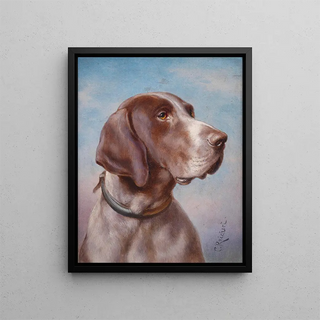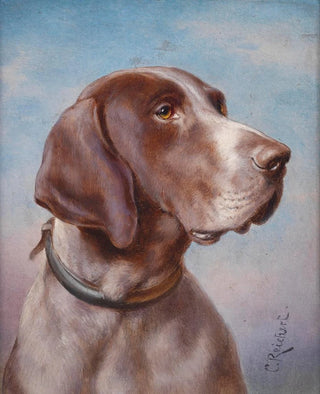Art print | Dog portrait - Carl Reichert


View from behind

Frame (optional)
Portrait of a dog - Carl Reichert – Captivating introduction
In the fascinating world of art, some works manage to capture the essence of a subject in such a poignant way that they transcend mere visuals to become testimonies of emotion and spirit. The "Portrait of a dog" by Carl Reichert is one such creation. This painting, which delicately illustrates the beauty of a dog, evokes not only the affection we can feel for these animals but also an introspective look at the relationship between humans and their faithful companions. The depiction of a pet, often considered a family member, is here elevated by Reichert's talent, offering viewers an invitation to explore the depth of the bonds that unite us with our four-legged friends.
Style and uniqueness of the work
Carl Reichert's style is rooted in the realism movement, where attention to detail and finesse of strokes are emphasized. In the "Portrait of a dog," each hair is rendered with such precision that one could almost feel the texture of the fur under their fingertips. Light plays a crucial role in this piece, accentuating shadows and reflections, bringing the animal to life. The expression of the dog, both gentle and attentive, seems to capture a moment of reflection, as if it were aware of its own gaze upon the world. This portrait does not merely depict an animal; it tells a story, that of a silent complicity between man and his companion, a universal theme that resonates through the ages.
The artist and his influence
Carl Reichert, an Austrian painter of the 19th century, is often recognized for his exceptional talent in depicting animals. His work is part of an artistic tradition that values nature and the creatures that inhabit it. Influenced by the great masters of his time, Reichert developed a style that is uniquely his own, blending realism with a touch of idealization. His paintings are not limited to simple representations; they reflect an artistic sensitivity that seeks to establish a dialogue between art and nature. By highlighting animals, Reichert invites us to reflect on our place in the natural world and on the bonds that

Matte finish

View from behind

Frame (optional)
Portrait of a dog - Carl Reichert – Captivating introduction
In the fascinating world of art, some works manage to capture the essence of a subject in such a poignant way that they transcend mere visuals to become testimonies of emotion and spirit. The "Portrait of a dog" by Carl Reichert is one such creation. This painting, which delicately illustrates the beauty of a dog, evokes not only the affection we can feel for these animals but also an introspective look at the relationship between humans and their faithful companions. The depiction of a pet, often considered a family member, is here elevated by Reichert's talent, offering viewers an invitation to explore the depth of the bonds that unite us with our four-legged friends.
Style and uniqueness of the work
Carl Reichert's style is rooted in the realism movement, where attention to detail and finesse of strokes are emphasized. In the "Portrait of a dog," each hair is rendered with such precision that one could almost feel the texture of the fur under their fingertips. Light plays a crucial role in this piece, accentuating shadows and reflections, bringing the animal to life. The expression of the dog, both gentle and attentive, seems to capture a moment of reflection, as if it were aware of its own gaze upon the world. This portrait does not merely depict an animal; it tells a story, that of a silent complicity between man and his companion, a universal theme that resonates through the ages.
The artist and his influence
Carl Reichert, an Austrian painter of the 19th century, is often recognized for his exceptional talent in depicting animals. His work is part of an artistic tradition that values nature and the creatures that inhabit it. Influenced by the great masters of his time, Reichert developed a style that is uniquely his own, blending realism with a touch of idealization. His paintings are not limited to simple representations; they reflect an artistic sensitivity that seeks to establish a dialogue between art and nature. By highlighting animals, Reichert invites us to reflect on our place in the natural world and on the bonds that






